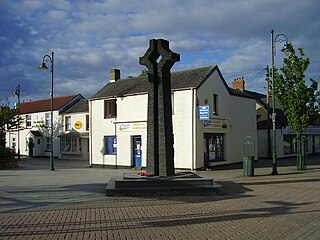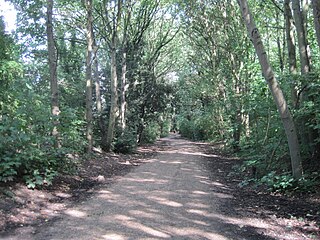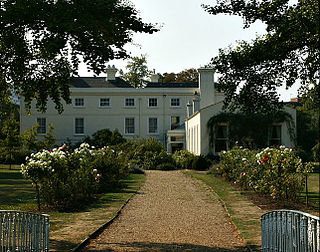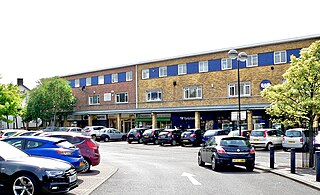
The National House Building Council (NHBC), established in 1936, is the UK's largest provider of new home warranties. According to NHBC's website, around 80% of new homes built in the UK each year have an NHBC 10-year warranty. NHBC is also the UK's largest single Approved Inspector for Building Regulations. Its other activities include the provision of services linked to house building and general construction; including energy ratings, health and safety, sustainability, and training. It also provides industry statistics and benchmarking services.

Caldicot is a market town and community in Monmouthshire, Wales. The town is located between Chepstow and the city of Newport. The site adjoins the Caldicot Levels, on the north side of the Severn Estuary. The population of the built-up area was around 11,000. It has a large school, Caldicot School, and is known for its medieval castle. The built-up area includes Portskewett. Caldicot had a population of 9,604 in 2011.

The Parkland Walk is a 3.1-mile (5.0 km) linear green pedestrian and cycle route in London, which follows the course of the railway line that used to run between Finsbury Park and Alexandra Palace, through Stroud Green, Crouch End, Highgate and Muswell Hill. It is often mistakenly described as 4.5 miles long, but even taking in the gap between the two sections it still only totals 3.1 miles (5.0 km). The route follows the bridges and cuttings of the line, but avoids the closed surface section of Highgate station and its adjoining tunnels, which are closed to walkers for safety reasons. The walk is almost all in Haringey, but a short stretch between Crouch Hill and Crouch End Hill is in Islington and this section incorporates Crouch Hill Park.

Morden Hall Park is a National Trust park on the banks of the Wandle in Morden, south London. Its several buildings and associated parking included, it is 51 acres (21 ha) of predominantly parkland. Hinting at the former mill leats the river here splits into channels, generally, through it spanned by numerous footbridges. The estate contains Morden Hall itself, Morden Cottage, two well-preserved snuff watermills, a restored stableyard, a dog-friendly café, exhibition space and second-hand bookshop. A western part, separately accessed, hosts the National Trust's only Garden Centre.

Rogiet is a small village and community in Monmouthshire, south east Wales, between Caldicot and Magor, 8 miles (13 km) west of Chepstow and 11 miles (18 km) east of Newport, which covers an area of 847 hectares (3.27 sq mi). It lies close to the M4 and M48 motorways, and the Second Severn Crossing. It has a railway station named Severn Tunnel Junction. Rogiet only has a population of 1,813 (2011).

Berwick Hills is a suburb in the Borough of Middlesbrough in North Yorkshire, England with a population of 4,465. It is east of Middlesbrough centre. The ward it belongs to is shared with the smaller area of Pallister. Both are separated by Ormesby Road.
Acklam Grange School is a co-educational secondary school located at Lodore Grove, Acklam, Middlesbrough, England.
The Code for Sustainable Homes was an environmental assessment method for rating and certifying the performance of new homes in United Kingdom. First introduced in 2006, it is a national standard for use in the design and construction of new homes with a view to encouraging continuous improvement in sustainable home building. In 2015 the Government in England withdrew it, consolidating some standards into Building Regulations.

The Building Research Establishment (BRE) is a centre of building science in the United Kingdom, owned by charitable organisation the BRE Trust. It is a former UK government national laboratory that was privatised in 1997. BRE provides research, advice, training, testing, certification and standards for both public and private sector organisations in the UK and abroad. It has its headquarters in Garston, Hertfordshire, England, with regional sites in Glasgow, Swansea, the US, India, the Middle East and China.
Oakdale is a large village in Caerphilly county borough, Wales, 9½ miles north of Caerphilly itself, within the historic boundaries of Monmouthshire. Situated in the Sirhowy valley, it is 1.5 miles (2.4 km) east of Blackwood, with which it forms a conurbation. At the 2001 census Oakdale had a population of 4,478.
Chepstow Rural District was a rural district in the administrative county of Monmouthshire, Wales. It was established under the Local Government Act 1894, and was abolished in 1974 when its functions were assumed by the new Monmouth District Council.
BREEAM, first published by the Building Research Establishment (BRE) in 1990, is the world's longest established method of assessing, rating, and certifying the sustainability of buildings. More than 550,000 buildings have been 'BREEAM-certified' and over two million are registered for certification in more than 50 countries worldwide. BREEAM also has a tool which focuses on neighbourhood development.
Both the public and private sectors in the United Kingdom promote green building. Presently, there are already regulatory mechanisms in place that establish Britain's commitment to this kind of building construction. The government, for instance, set out a target that by 2016, all new homes will have zero carbon emission and it also includes a progressive tightening of energy efficiency regulations by 25 percent and 44 percent in 2010 and 2013, respectively. The UK Building Regulations set requirements for insulation levels and other aspects of sustainability in building construction.

Willmott Dixon is a British privately owned contracting, residential development and property support business.

The Skinners' Kent Academy is a secondary school with academy status in Royal Tunbridge Wells, England.
Monmouth Comprehensive School is a comprehensive secondary school for pupils aged 11–18, situated in Monmouth, Monmouthshire, Wales.
Nicholas Hare Architects is a UK architectural practice, with a portfolio of award-winning projects. These include schools, higher education, refurbishment, commercial projects, and buildings for the arts. Founded by Nicholas Hare in 1977, the practice is now a limited liability partnership with over 50 employees. The office is based in an old book-binding factory in Barnsbury Square in Islington. Nicholas Hare Architects LLP is a member of the UK Green Building Council and achieves BREEAM Excellent rating for several of its completed buildings.

Old St Mellons is a village, a community and a civil parish on the eastern edge of Cardiff, Wales. Lying to the east of the Rhymney River, it forms part of the historic county of Monmouthshire. It is separated from the modern St Mellons suburb by the main road to Newport – the Newport Road (B4487) – and which was formerly the A48 road.

Aberfeldy Village is an urban village in Poplar, London, England, which is in the process of being redeveloped in a joint venture between Poplar HARCA and Willmott Dixon. It was known as the Aberfeldy Estate, a housing estate but has expanded. It is sometimes referred to as Aberfeldy New Village in planning documents.

Green building certification systems are a set of rating systems and tools that are used to assess a building or a construction project's performance from a sustainability and environmental perspective. Such ratings aim to improve the overall quality of buildings and infrastructures, integrate a life cycle approach in its design and construction, and promote the fulfillment of the United Nations Sustainable Development Goals by the construction industry. Buildings that have been assessed and are deemed to meet a certain level of performance and quality, receive a certificate proving this achievement.













